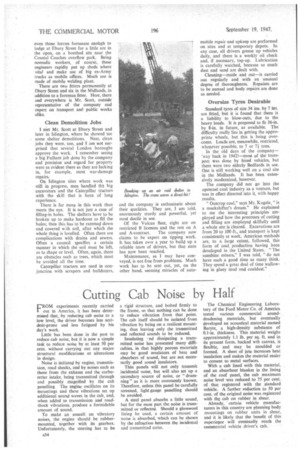Cutting Cab Noise by Half
Page 44

If you've noticed an error in this article please click here to report it so we can fix it.
FROM experiments recently carried out in America, it has been determined that, by reducing cab noise to a low level, the driver becomes less accident-prone and less fatigued by his day's work.
Little has been done in the past to reduce cab noise, but it is now a simple task to reduce noise by at least 50 per cent, without carrying out any major structural modifications or alterations in design.
Noise is initiated by engine, transmission, road shocks, and by noises such as those from the exhaust and the carburetter intake, being transmitted through and possibly magnified by the cab panelling The engine oscillates on its mountings and these vibrations set up additional sound waves in the cab, and, when added to transmission and roadshock vibrations, produce a formidable amount of sound.
To make an assault on vibratory noises, the engine should be rubbermounted, together with its gearbox. Unfortunately_ the steering has to be a rigid structure, and bolted firmly to the frame, so that nothing can be done to reduce vibration from that point. The cab itself should be isolated from vibration by bring on a resilient mounting. thus leaving only the transmitted and reflected sounds to be reduced.
Insulating -nd dissipating a transmitted noise has presented many difficulties, in that highly porous materials may be good insulators of heat and absorbers of sound, but are not necessarily good sound insulators.
Thin panels will not only transmit incidental noise, but will also set up a secondary source of noise, or " drumning " as it is more commonly known. Therefore, unless this panel be carefully screened, light gauge panelling should be avoided.
A steel panel absorbs a little sound, but for the most part the noise is transmitted or reflected. Sbould a glasswool lining be used, a certain amount of noise is absorbed, which can be shown by the refraction between the incidental and transmitted noise. The Chemical Engineering Laboratory of the Ford Motor Co. of America tested various commercial sounddeadening materials, but eventually developed an acoustical material named Baryte, a high-density substance of 0.1-in. thickness. This material weighs approximately 1.1 lb. per sq. ft. and in its present form, backed wth canvas, is flexible, and may be moulded or formed. A sheet of jute increases heat insulation and makes the material easier to cement to metal surfaces_ With a cab lined with this material, and an absorbent blanket in the lining of the roof panel, the cab maximum noise level was reduced to 75 per cent. of that registered with the standard vehicle. A further reduction to 50 per cent, of the original noise was registered with the cab on rubber in shear.
Already, certain vehicle manufacturers in this country are planning body mountings on rubber units in shear, and it is likely that the benefit of this experience will eventually reach the cotrunercial vehicle driver's cab.












































































